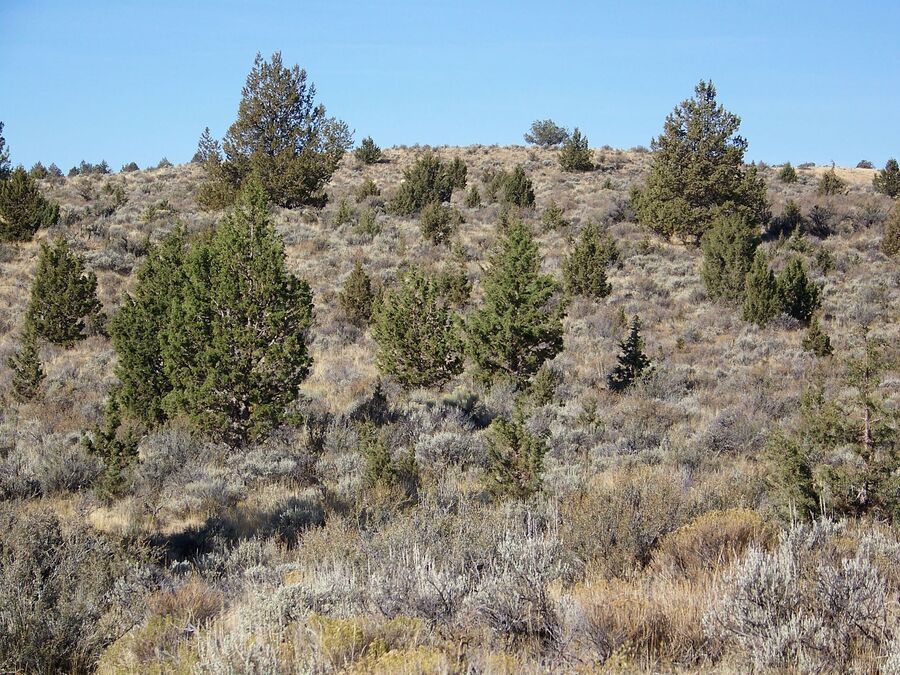Extensive research shows that native conifer trees, such as juniper and pinyon pine, have been increasing their footprint on the landscape at an unprecedented rate for the past 150 years, especially in places such as the Great Basin, where 1.1 million acres have transitioned from shrubland or rangeland to woodlands since 2000. This accelerated conversion of shrubland and grassland ecosystems to woodlands is having undesirable impacts, including the loss of unique wildlife and wildlife habitat, reduced water availability and increased runoff and erosion, less land available for livestock grazing, and greater fuel loading for wildfires.
A new website by the collaborative “PJ (pinyon-juniper) Encroachment Education Project” sheds light on the issue. The site is also a resource for those trying to manage this threat, particularly in the Great Basin, where encroaching pinyon pine and juniper trees are taking over sagebrush ecosystems and contributing to the decrease of imperiled species such as the sage grouse.
“The whole thrust of this project is to provide science-based information on the ecology and impacts of the problem, as well as the collaborative work being done to address it,” said Christina Restaino, natural resource specialist with University of Nevada, Reno Extension, the organization leading the project. “The website is intended to help people understand the issue and serve as a clearinghouse of information to help land managers, professionals and agencies throughout the West in their collaborative efforts.”
Restaino, who is also an assistant professor in the University’s College of Agriculture, Biotechnology & Natural Resources, said a new report by the U.S. Geological Survey and Western Association of Fish & Wildlife Agencies identifies tree encroachment as one of the top three threats to sagebrush ecosystems – the other two being invasive species and land development.
The website launched today and includes sections explaining the ecology of how and where the conversion is happening, as well as outlining the impacts of sagebrush range converting to woodlands. The “Resilience in Action” section shows projects being done around the West to manage the issue. Finally, there is an impressive “See the Science” section, where online viewers can search a database with over 400 peer-reviewed articles on an interactive map for information on the issue by location, topic, key word or year.
The partners in the project worked for two years to build the website, diving into research; holding multiple stakeholder working sessions; working with web designers to create an organized, easy-to-navigate site; and working with a technical illustrator to provide clear, accessible graphics for the site. Partners in the project include the USDA Natural Resources Conservation Service’s Working Lands for Wildlife partnership, the Bureau of Land Management, and the Intermountain West Joint Venture’s Partnering to Conserve Sagebrush Rangelands initiative.
“Communicating why more trees everywhere isn’t always a good thing is a real challenge for land managers charged with conserving nonforest lands,” said Jeremy Maestas, who is part of the working group and a sagebrush ecosystem specialist with the USDA-NRCS. “With Extension, we were able to build a website that helps broad audiences understand the science behind the problem.”
Besides the devastating effect on sagebrush-dependent wildlife, Maestas points out there are also economic impacts of the encroachment.
“In the Intermountain West, 90% of tree encroachment has occurred in sagebrush shrublands, a habitat type that has already been reduced by half due to a wide variety of threats. Species like sage grouse, found nowhere else in the world, will abandon breeding habitats when there are just a few trees per acre. Encroaching trees also suck up precious soil moisture needed on arid lands to grow other native grasses and wildflowers, which means less food and cover not only for wildlife, but also for livestock that sustain rural agricultural economies in the West.”
Mandi Hirsch, sagebrush collaborative conservation specialist for the Intermountain West Joint Venture and leader of the Partnering to Conserve Sagebrush Rangelands initiative, is also part of the project’s working group. She knows firsthand the impact the encroachment of trees on rangeland can have to ranchers. Hirsch is a rancher at heart and by trade who now also works toward the conservation and sustainability of Western rangelands.
“The conservation of a unique species like sage grouse is very important, but it’s only part of the entire picture when managing natural resources at a landscape scale. What many people don’t realize is there are many other potentially devastating impacts of encroachment – including jeopardizing the livelihoods of our ranchers and their ability to produce food. I really think this website can help people to understand that, and all the other impacts of this encroachment. And, I think it will be a tremendous ongoing resource for those trying to do something about it.”















